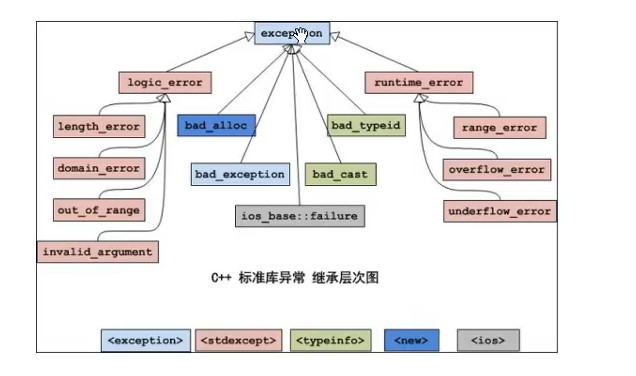本文最后更新于:2021年2月8日 晚上
概览:C++异常,自定义异常类型以及栈解旋。
c++异常之简单的语法
1
2
3
4
5
6
7
8
9
10
11
12
13
14
15
16
17
18
19
20
21
22
23
| #include <iostream>
using namespace std;
int division(int a, int b) {
if (b == 0) throw b;
else return a / b;
}
int main() {
try{
division(10, 0);
}
catch (int e) {
cout << "被除数为" << e << endl;
}
return 0;
}
|
C++异常的优点
- C++函数的返回值可以被忽略,但是异常是不能被忽略的。如果程序出现了异常,但是没有被捕获,程序就会终止。(C++异常必须被处理)这样可以使得程序更加健壮。
- 函数返回值可能没有什么语义信息,但是异常却可以包含语义信息,例如异常类名就可以。
- 异常作为一个类,可以拥有自身的成员,这些成员足以传递信息。
- 异常的处理可以跳级调用,当在多个函数的调用栈时出现了异常,不需要每级函数都进行处理,只需要在某一处进行处理即可。
C++异常接口声明
1
2
3
4
5
6
7
8
9
10
11
12
13
14
15
16
17
18
19
20
21
22
23
24
25
26
27
28
29
30
31
32
33
34
| void excpt1() throw (int,float,double)
{
throw "abc";
}
void excpt2() throw()
{
}
void excpt3()
{
}
void test3() {
try {
excpt1();
}
catch(...){
cout << "1发生异常" << endl;
}
excpt2();
excpt3();
}
|
异常类型自定义
1
2
3
4
5
6
7
8
9
10
11
12
13
14
15
16
17
18
19
20
21
22
23
24
25
26
27
28
29
30
31
32
33
34
35
36
37
38
|
class MyException {
public:
MyException(string err) {
m_err = err;
}
MyException(const MyException& other) {
m_err = other.m_err;
}
MyException& operator=(const MyException& other) {
if (this == &other)
return *this;
m_err = other.m_err;
return *this;
}
void showError() {
cout << this->m_err << endl;
}
private:
string m_err;
};
void throwEcp() {
throw MyException("异常发生");
}
void test4() {
try {
throwEcp();
}
catch (MyException e) {
e.showError();
}
}
|
我在Applied C++这本书中看到了可以在类的成员中定义一个异常类,然后发生异常时抛出这个异常类的对象。
C++异常跨函数
C++的异常机制可以跨函数进行处理,但是C++异常必须是需要处理的,否则就会报错。
函数逐层调用时,一个函数抛出异常,则该异常会逐级向上抛出,如果该异常到了顶层都没有被处理的话,程序就会出错。
1
2
3
4
5
6
7
8
9
10
11
12
13
14
15
16
17
18
19
20
21
22
| int division(int a, int b) {
if (b == 0) throw b;
else return a / b;
}
int driver(int a, int b) {
return division(a, b);
}
void test2() {
try{
driver(10,0);
}
catch(int e){
cout << "被除数为" << e << endl;
}
}
|
栈解旋
异常被抛出后,从进入try块起,到异常被抛出前的这段时间里,在栈上构造的所有对象,都会被自动析构。
析构的顺序与构造的顺序相反,这就是栈解旋。
1
2
3
4
5
6
7
8
9
10
11
12
13
14
15
16
17
18
19
20
21
22
23
24
25
26
27
28
29
30
31
32
| class Person {
public:
Person() {
cout << "对象创建"<<endl;
}
~Person() {
cout << "对象析构" << endl;
}
};
int personDriver(int a, int b) {
Person p;
return division(a, b);
}
void test4() {
try {
personDriver(10, 0);
}
catch (int e) {
cout << "捕获异常: " << e << endl;
}
}
|
输出结果:
异常变量的生命周期
- catch捕获的异常变量如果是普通类型对象,非指针非引用,会调用拷贝构造,异常处理完之后就会析构。
- 而引用类型,也不会调用拷贝构造,异常处理之后就会析构。
- 指针类型则比较特别,先构造然后析构。
1
2
3
4
5
6
7
8
9
10
11
12
13
14
15
16
17
18
19
20
21
22
23
24
25
26
27
28
29
30
31
32
33
34
35
|
class MyException {
public:
MyException() {
cout << "普通构造函数" << endl;
}
MyException(const MyException& other) {
cout << "拷贝构造函数" << endl;
}
MyException& operator=(const MyException& other) {
cout << "重载=函数" << endl;
return *this;
}
~MyException() {
cout << "析构函数" << endl;
}
void showError() {
cout << "抛出异常" << endl;
}
};
void excp1() {
throw MyException();
}
void excp2() {
throw &MyException();
}
void excp3() {
throw new MyException();
}
|
1. 普通类型对象
1
2
3
4
5
6
7
8
9
10
| void test1() {
try {
excp1();
}
catch (MyException e) {
e.showError();
}
}
|
执行结果:
1
2
3
4
5
| 普通构造函数
拷贝构造函数
抛出异常
析构函数
析构函数
|
2.引用
1
2
3
4
5
6
7
8
9
| void test2() {
try {
excp1();
}
catch (MyException &e) {
e.showError();
}
}
|
执行结果:
3.指针
对于使用指针来捕获异常对象,需要使用excp3()这样的方式,而不是excp2()这样的方式。函数2会产生错误。
1
2
3
4
5
6
7
8
9
10
11
| void test3() {
try {
excp3();
}
catch (MyException *e) {
e->showError();
delete e;
}
}
|
执行结果:
编写自己的异常类

- 建议自己的异常类要继承标准异常类,不容易导致混乱。
- 当继承标准异常类的时候,应当重载父类的
what函数以及虚析构函数。
- 在栈展开过程中,要复制异常类型,即会有拷贝操作。那么要根据类的成员来判断是否需要自行提供拷贝构造函数。
标准异常类名:exception,其所在头文件为#include <stdexcept>。

1
2
3
4
5
6
7
8
9
10
11
12
13
14
15
16
17
18
19
20
21
22
23
24
25
26
27
28
29
30
31
32
33
34
35
36
37
38
39
40
41
42
43
44
45
46
47
48
49
50
51
52
53
54
55
56
57
58
59
60
61
62
63
64
65
66
67
68
69
70
71
| #include <iostream>
#include <stdexcept>//标准异常的头文件
using namespace std;
class MyException :public exception
{
public:
MyException(const char* error)
{
myError = new char[strlen(error) + 1];
strcpy_s(myError, strlen(error) + 1, error);
}
MyException(const MyException& e)
{
myError = new char[strlen(e.myError) + 1];
strcpy_s(myError, strlen(e.myError) + 1, e.myError);
}
MyException& operator=(const MyException& e)
{
myError = new char[strlen(e.myError) + 1];
strcpy_s(myError, strlen(e.myError) + 1, e.myError);
}
~MyException()
{
if (myError != nullptr)
{
delete[] myError;
myError = nullptr;
}
}
virtual const char* what() const
{
return myError;
}
public:
char* myError;
};
class Person {
public:
Person()
{
mAge = 0;
}
void setAge(int age)
{
if (age < 0 || age >= 120)
{
throw MyException("年龄超出正常人类!");
}
else this->mAge = age;
}
public:
int mAge;
};
int main()
{
Person p1;
try {
p1.setAge(-45);
}
catch (exception& e)
{
cout << e.what() << endl;
}
return 0;
}
|

